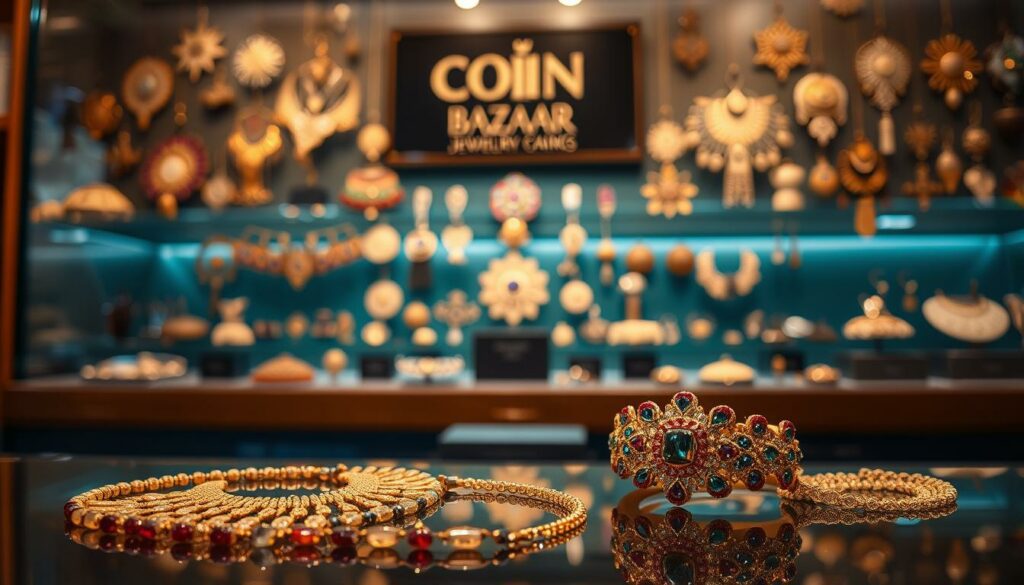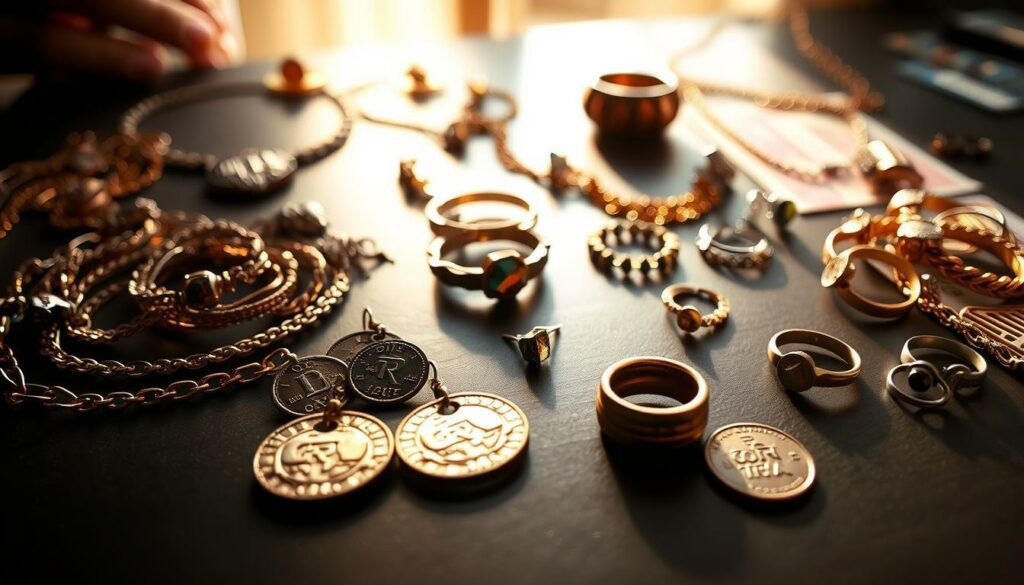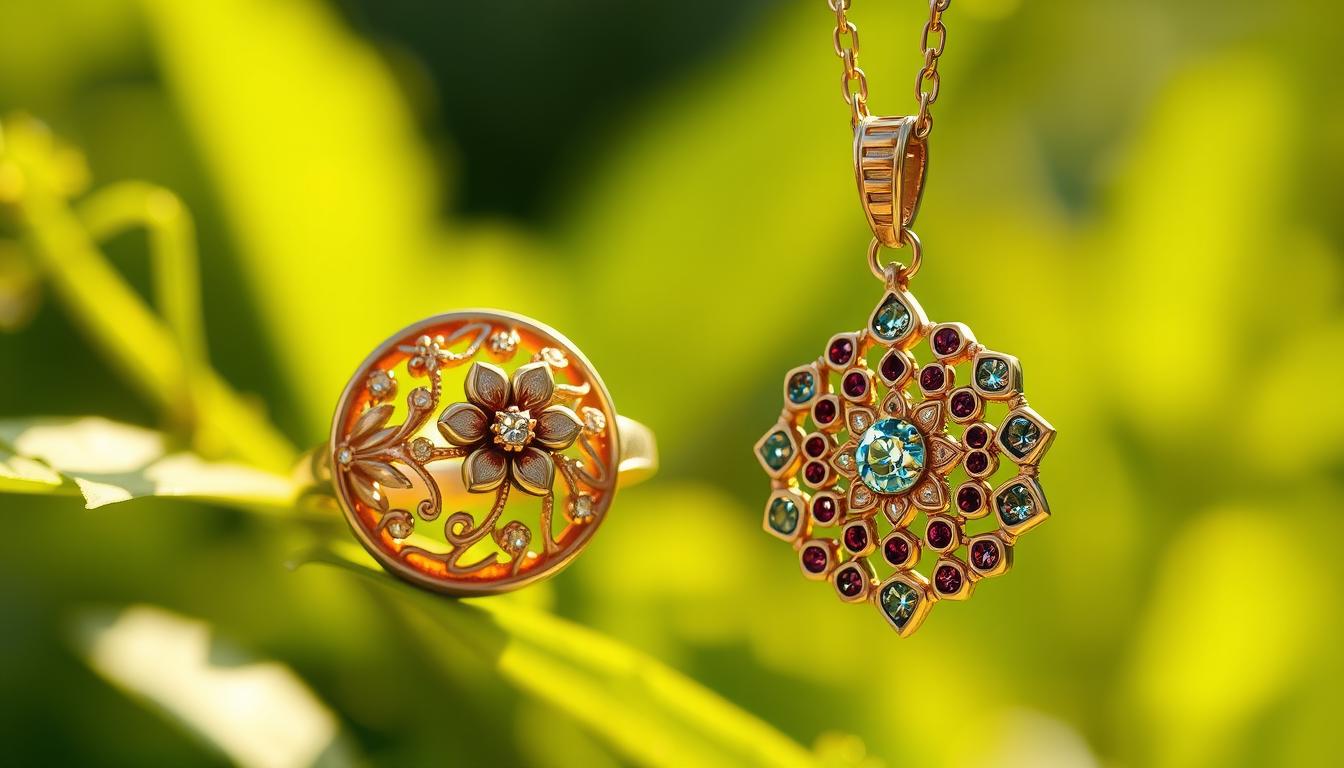As you become more environmentally conscious, you’ve noticed a big change. The Indian jewelry industry is now focusing more on eco-friendly jewelry.
There’s a growing need for sustainable jewelry materials. This is because people are becoming more aware of the harm traditional jewelry making causes to the environment and society.
You’re looking for jewelry that’s not just beautiful but also helps the planet. You want pieces that make a difference.
This change towards sustainable fashion in jewelry is changing how jewelry is made and sold in India. It’s a big shift.
Key Takeaways
- Eco-friendly jewelry is gaining popularity in India.
- Sustainable jewelry materials are in high demand.
- The shift towards sustainable fashion is driven by environmental awareness.
- Consumers are seeking unique and meaningful jewelry pieces.
- The jewelry industry is transforming towards more sustainable practices.
The Growing Demand for Ethical Adornments in India
More people in India want green jewelry supplies now. You’re not alone in looking for jewelry that’s both stunning and eco-friendly. This change comes from a growing awareness of jewelry’s environmental and social effects.


Shifting Consumer Awareness and Values
Today, people care more about where and how things are made, including jewelry. You’re part of a growing crowd looking for ethical materials for jewelry that match your values. This trend shows in the rise of eco-friendly and sustainable jewelry.
Environmental Consciousness in the Indian Jewelry Market
The Indian jewelry market is answering the call for sustainable jewelry. Your choice to buy eco-friendly jewelry is pushing this change. A leading designer says, “The future of jewelry is about looking and feeling good.”
The industry is now usingsustainable practicesandeco-friendly materialsin their designs.
Sustainable Jewelry Materials: A Comprehensive Overview
The jewelry industry is changing fast. People want materials that are good for the planet. This means looking for environmentally friendly jewelry components more than ever.
Defining Sustainability in Jewelry Context
Sustainable jewelry means using materials and methods that don’t harm the environment. This includes recycled metals, conflict-free gemstones, and lab-grown diamonds. It’s not just about the materials; it’s also about how they’re made.
Environmental Impact Assessment Metrics
Experts use different ways to check if jewelry is sustainable. They look at carbon footprint, water use, and waste. This helps makers choose better options for the planet.
Ethical Sourcing Standards and Practices
Ethical sourcing is key in sustainable jewelry. It means getting materials in a way that respects people and the planet.
Labor Considerations
One important part of ethical sourcing is treating workers right. This means they are paid fairly and work in safe places. Fair labor helps make the jewelry world better for everyone.
Supply Chain Transparency
Being open about where materials come from is also crucial. This builds trust with customers. It shows companies are accountable and working towards a greener future.


When you look for conscious jewelry making, think about the whole journey of the jewelry. Choosing sustainable options means you get to enjoy beautiful pieces while helping the planet.
India’s Traditional Eco-Friendly Jewelry Heritage
For centuries, Indian jewelry has been made with care for the environment. This is seen in the eco-friendly techniques passed down through generations.
Clay, Terracotta, and Earthen Jewelry Forms
Artisans in India have used clay, terracotta, and earth for beautiful sustainable jewelry. These materials are easy to find, break down naturally, and need little processing. They’re perfect for those who care about the planet.
Natural Fibers and Textile-Based Adornments
Natural fibers like cotton, silk, and wool make intricate jewelry. These materials are good for the planet and add a unique look to Indian jewelry.
Plant-Based Materials in Regional Jewelry Traditions
India’s regions have their own plant-based jewelry traditions. From seed jewelry to flower and leaf adornments, these pieces are eco-friendly and deeply rooted in local culture.
Seed Jewelry from Rural India
In rural India, seeds make beautiful, detailed jewelry. This tradition supports local artisans and promotes sustainability.
Flower and Leaf-Based Temporary Adornments
During festivals and ceremonies, you’ll see jewelry made from flowers and leaves. These items are biodegradable and add to the festive atmosphere.
| Material | Region | Sustainability Feature |
|---|---|---|
| Clay/Terracotta | Rajasthan | Biodegradable |
| Natural Fibers | Kerala | Renewable Resources |
| Seeds | Rural India | Locally Sourced |
Recycled Precious Metals in Contemporary Indian Designs
In Indian jewelry, recycled precious metals are becoming more popular. This is because they are eco-friendly. People are now looking for jewelry that is good for the planet.
Recycled metals are a green choice compared to mining. They help make jewelry production less harmful to the environment. Let’s look at how reclaimed gold, recycled silver, and other metals are used.
Reclaimed Gold: Processes and Benefits
Reclaimed gold comes from old jewelry and electronic waste. It’s collected, refined, and reshaped into new pieces. This method cuts down on mining and helps save gold.
Recycled Silver’s Growing Popularity
Recycled silver is also becoming more popular in jewelry. It’s made from old silverware and industrial waste. The recycling process is good for the planet and saves money.
Sustainable Brass, Copper, and Bronze Alternatives
Brass, copper, and bronze are being used in new ways in jewelry. They come from industrial waste and old artifacts. These metals add a unique look and support sustainable practices.
| Metal | Source | Benefits |
|---|---|---|
| Reclaimed Gold | Old jewelry, electronic waste | Reduced mining, lower carbon footprint |
| Recycled Silver | Old silverware, industrial waste | Eco-friendly, cost-effective |
| Sustainable Brass, Copper, Bronze | Industrial waste, old artifacts | Unique aesthetic, sustainable practices |
Ethically Sourced Gemstones and Sustainable Alternatives
Indian consumers are now looking for jewelry made from ethically sourced gemstones and sustainable materials. This change is because they want to lessen the harm to the environment and society. They want their choices to be better for the planet.
Responsibly Mined Natural Gems in Indian Jewelry
Indian shoppers are choosing responsibly mined natural gems. These gems are mined in ways that harm the environment less and treat workers fairly. Certifications like the Kimberley Process help prove that these diamonds and stones are ethically sourced.
Lab-Grown Diamonds: The Ethical Revolution
Lab-grown diamonds are becoming a favorite choice. They are made with technology that mimics how diamonds form naturally. This makes them identical to mined diamonds but with less environmental harm. The ethical appeal of lab-grown diamonds is their green credentials and fair production.
Glass, Ceramic, and Resin Substitutes
People are also exploring sustainable alternatives to gemstones. Glass, ceramic, and resin are being used to make stylish and budget-friendly jewelry. These materials are often better for the planet than mining gemstones.
Traditional Glass Work in Modern Context
Modern jewelry is incorporating traditional glasswork. This mix of old and new creates unique, colorful pieces. Artisans are using old techniques to make new, sustainable jewelry.
Ceramic Jewelry Innovations
Ceramic jewelry is seeing a lot of creativity. Ceramic materials offer a wide range of colors and textures. This makes them a great choice for those wanting something unique from traditional jewelry.
As more people want sustainable jewelry, we’ll see more creative uses of ethically sourced materials in Indian designs.
Innovative Bio-Based Jewelry Components
A new trend in Indian jewelry is using eco-friendly, bio-based materials. The jewelry world is moving towards being more sustainable. This change is because people want products that are good for the planet.
This shift has brought about new, sustainable jewelry components. These components are not only better for the environment. They also open up new design possibilities.
Plant Resins and Bioplastics in Indian Designs
Plant resins and bioplastics are becoming popular in Indian jewelry. These materials come from plants and break down easily, making jewelry production less harmful. Designers are making beautiful, eco-friendly pieces with these materials.
For example, bioplastics made from corn or sugarcane are being shaped into various forms. This offers a green alternative to regular plastics.
Agricultural Waste Transformed into Luxury
Agricultural waste is being turned into luxury jewelry. This shows how sustainable design can be both beautiful and valuable. By using waste, designers create unique, eco-friendly items.
This approach also gives new life to materials that would otherwise be thrown away. For instance, coconut and rice husks are being used to make strong, lovely jewelry.
| Material | Source | Environmental Benefit |
|---|---|---|
| Plant Resins | Renewable plant sources | Biodegradable, reducing plastic waste |
| Bioplastics | Corn starch, sugarcane | Reduces dependence on fossil fuels |
| Agricultural Waste | Coconut husks, rice husks | Reduces waste, promotes upcycling |
Mycelium and Mushroom-Based Materials
Mycelium and mushroom-based materials are becoming part of jewelry design. Mycelium, the mushroom’s growth part, makes sustainable materials. These materials are strong and versatile, used in eco-friendly jewelry.
These pieces are not only good for the planet. They also have a unique look. The use of mycelium shows the jewelry industry’s move towards sustainability.
As people care more about the environment, eco-friendly jewelry demand will grow. Bio-based materials will play a big role in this change. They offer sustainable options that don’t sacrifice style or quality.
Upcycled Materials Creating Unique Indian Jewelry
Now, you can find beautiful, one-of-a-kind Indian jewelry made from upcycled materials. This shows a shift towards making jewelry that’s good for the planet. Designers are using materials that would otherwise be thrown away, turning them into stunning jewelry pieces.
Sari Silk and Textile Waste Innovations
Sari silk and textile waste are big sources for upcycled jewelry in India. Artisans are turning old saris and fabric scraps into intricate, handcrafted jewelry. This not only cuts down on waste but also keeps traditional Indian textile heritage alive. The result is unique, eco-friendly jewelry that’s both stylish and meaningful.
Industrial Byproducts Reimagined as Adornments
Industrial byproducts are also being used in upcycled jewelry. Designers are making jewelry from waste materials from different industries. This not only helps the environment but also brings creativity to the designs.
Paper and Cardboard Jewelry
Paper and cardboard, often seen as useless for jewelry, are being used to make eco-friendly accessories. Artisans are creating intricate designs from these materials. This shows the potential for making jewelry that’s good for the planet.
Metal Scrap Transformations
Metal scrap, once seen as waste, is now being turned into striking jewelry. By using metal scraps, designers are making unique, durable, and eco-friendly jewelry. This appeals to people who care about the environment.
These new uses for upcycled materials are not only reducing waste but also changing jewelry design in India. As people become more aware of the environmental impact of their choices, the demand for eco-friendly jewelry keeps growing.
Indian Artisans at the Forefront of Sustainable Craftsmanship
Indian artisans are changing the jewelry world with their focus on green craftsmanship. They mix old techniques with new eco-friendly methods. This creates unique, green pieces that people all over love.
Traditional Techniques Meeting Modern Sustainability
Indian artisans are amazing at using green gems and metals in their work. They use old ways like hand-forging and detailed designs. This makes beautiful pieces from recycled metals and conflict-free stones.
Many are now using environmentally friendly jewelry components. This includes plant-based materials and recycled metals. It helps them leave a smaller mark on the planet.
Skill Development and Green Jewelry Making Programs
There are special programs in India to help artisans grow in green jewelry making. These programs teach them new, green techniques. This ensures they can succeed in the changing market.
| Traditional Technique | Modern Sustainability Practice | Resulting Benefit |
|---|---|---|
| Hand-forging | Using recycled precious metals | Reduced environmental impact |
| Intricate detailing | Incorporating conflict-free gemstones | Ethical sourcing |
| Traditional craftsmanship | Using plant-based materials | Innovative designs |
By using these green practices, Indian artisans keep their culture alive. They also help make the jewelry world more eco-friendly.
Pioneering Sustainable Jewelry Brands Across India
Exploring Indian jewelry, you’ll find brands leading the way with sustainability. They create stunning pieces while focusing on ethical and eco-friendly methods.
Luxury Houses Championing Ethical Materials
Luxury brands in India are now using sustainable materials. They opt for recycled precious metals and ethically sourced gemstones. This sets a new standard for luxury jewelry, showing it can be both elegant and green.
Mid-Market Brands with Eco-Conscious Collections
Mid-market brands are also going green. They offer eco-friendly jewelry options for more people. Using eco-conscious jewelry findings and ethical beads and stones, they meet the needs of those who care about the planet.
Affordable Sustainable Jewelry Enterprises
Affordable, sustainable jewelry is becoming more common in India. These brands are creative with materials and methods. They make eco-friendly jewelry affordable for everyone.
Online-Only Sustainable Jewelry Retailers
Online retailers are big in promoting sustainable jewelry in India. They have a variety of eco-friendly options. They also share details on how the jewelry is made, helping buyers make smart choices.
Artisan Cooperatives and Direct Trade Models
Artisan cooperatives and direct trade models support local artisans and sustainability. They ensure fair pay and preserve traditional crafts. This helps keep India’s cultural heritage alive.
These brands are changing the Indian jewelry scene. They encourage consumers to choose eco-friendly options. As demand grows, we’ll see even more innovative brands in the future.
Certification Standards for Green Jewelry Supplies
The need for eco-friendly jewelry is rising fast. This means certification standards are getting more important. As a buyer, you might see many labels and claims. But it can be hard to know what they really mean.
Indian Sustainability Certification Bodies
India has its own groups checking if jewelry is eco-friendly. These groups set standards for making jewelry with sustainable materials and methods. For example, some focus on jewelry made from recycled metals or gemstones that are free from conflict.
International Standards Gaining Traction in India
International standards are also becoming more popular in India. These standards follow global best practices in being green and fair. By using these standards, Indian jewelry makers show they care about the planet on a world scale.
Verifying Eco-Friendly Jewelry Claims
To check if jewelry is really eco-friendly, look for certifications from trusted groups. These certifications mean the jewelry meets certain green and fair standards. By picking certified jewelry, you help support sustainable jewelry materials and methods.
As more people want eco-friendly jewelry, standards will be key in the industry’s future. Knowing and looking for these certifications helps you make choices that match your values.
Cultural Significance of Sustainable Materials in Indian Jewelry
Indian jewelry is changing, with a focus on sustainable and ethical pieces. More people want green jewelry supplies because they care about the planet.
Wedding Jewelry’s Sustainable Evolution
Indian wedding jewelry is famous for its beauty and luxury. Now, couples choose eco-friendly options. They use recycled precious metals and ethically sourced gemstones in their wedding outfits.
This change helps the environment and adds depth to traditional jewelry.
Religious and Ceremonial Sustainable Adornments
In India, jewelry is key in religious and ceremonial events. Sustainable materials are becoming popular. Artisans make stunning religious jewelry from plant-based materials and recycled metals.
Festival-Specific Eco-Friendly Jewelry
During festivals, people wear colorful jewelry. Now, there’s a trend for eco-friendly festival jewelry. It’s made from bioplastics and upcycled components.
Regional Variations in Sustainable Materials
India’s different regions have their own sustainable jewelry styles. Some like terracotta and earthen jewelry, while others prefer natural fibers and textile-based adornments. This variety makes Indian jewelry even more special.
| Region | Sustainable Materials Used |
|---|---|
| Rajasthan | Terracotta, Earthen Jewelry |
| Tamil Nadu | Natural Fibers, Textile-Based Adornments |
| Punjab | Recycled Metals, Bioplastics |
A famous jewelry designer says, “Sustainability is essential for Indian jewelry’s future.” This view is shared by many, pushing the industry towards greener practices.
“The future of Indian jewelry lies in its ability to blend tradition with sustainability, creating pieces that are not only beautiful but also environmentally conscious.”
Price Points and Accessibility of Conscious Jewelry
More and more people want sustainable choices, making the cost and availability of eco-friendly jewelry key. The jewelry world is changing fast. It’s moving towards green and responsible products because of what customers want.
Cost Analysis: Conventional vs. Sustainable Options
Comparing the cost of making eco-friendly jewelry to traditional methods shows a difference. Sustainable materials and fair sources can make things pricier. Yet, many are happy to spend more for jewelry that’s good for the planet. The price gap between old and new ways depends a lot on the materials used.
| Material | Conventional Cost | Sustainable Cost |
|---|---|---|
| Gold | $500/oz | $600/oz (recycled) |
| Diamonds | $300/carat | $200/carat (lab-grown) |
Making Ethical Jewelry Accessible to All Indians
To make eco-friendly jewelry more available in India, brands are getting creative. They’re using local materials and setting prices that everyone can afford. As one expert says,
“The future of jewelry lies in sustainability and accessibility.”
Consumer Guide: How to Identify Genuine Environmentally Friendly Jewelry
India’s jewelry market is moving towards sustainable choices. But how do you know if what you’re buying is really eco-friendly? It’s important to understand the materials and methods used in making your jewelry.
Essential Questions for Ethical Jewelry Shopping
When looking for sustainable jewelry, ask the right questions. Find out where the materials come from, how they’re made, and the brand’s commitment to the environment. Look for clear information on the use of sustainable gems and metals and ethical beads and stones.
Recognizing Greenwashing in the Indian Market
Watch out for brands that claim their jewelry is eco-friendly without proof. Look for certifications from trusted organizations and read what other customers say. This helps you know if the brand’s claims are true.
Resources for Informed Purchasing Decisions
To make smart choices, use online tools and join community groups and forums. These resources offer insights into the sustainability of different jewelry brands.
Online Verification Tools
There are online platforms that check if jewelry brands are really eco-friendly. These tools help you find brands that follow green practices.
Community Groups and Consumer Forums
By joining groups and forums, you connect with others who care about sustainable jewelry. These places are great for sharing tips and experiences.
| Resource Type | Description | Benefits |
|---|---|---|
| Online Verification Tools | Platforms that verify the sustainability claims of jewelry brands. | Ensures authenticity, provides transparency. |
| Community Groups | Forums and groups where consumers share their experiences with sustainable jewelry. | Offers insights, fosters community engagement. |
Future Innovations in Sustainable Jewelry Materials
The jewelry industry is moving towards a greener future. It’s using new, sustainable materials and methods. This change is because more people want eco-friendly jewelry.
Emerging Technologies and Material Science
New technologies and science are changing jewelry. Things like 3D printing and lab-grown diamonds are making jewelry production better for the planet. Bio-based materials, like plant-based composites, are also being looked at.
“The future of jewelry is about being both beautiful and green,” says a top designer. “We’re moving towards materials that are good for the planet and show our commitment to innovation.”
India’s Role in Global Sustainable Jewelry Trends
India is leading in sustainable jewelry, thanks to its rich history and focus on eco-friendly practices. Indian jewelers are using sustainable materials in their work. This includes recycled metals and conflict-free gemstones.
India is not just making jewelry; it’s setting trends in sustainability. As more people want sustainable jewelry, India’s role will grow. It’s combining old skills with new, green practices.
Conclusion: Embracing a Greener Future for Indian Jewelry
Exploring sustainable jewelry in India shows a bright future ahead. More people and brands are choosing eco-friendly options. This is because they care about the environment and social issues.
The move towards eco-friendly jewelry is more than a trend. It’s changing the Indian jewelry industry. Now, you can wear beautiful, eco-friendly jewelry that’s good for the planet.
When shopping, look for brands that care about the environment. Choosing sustainable jewelry helps support a greener industry. It also helps keep India’s rich culture alive.
The future of Indian jewelry looks very promising. Your choices can make it even better. Join the movement towards eco-friendly jewelry for a sustainable tomorrow.














